6+ Sample Construction Price Proposal
-
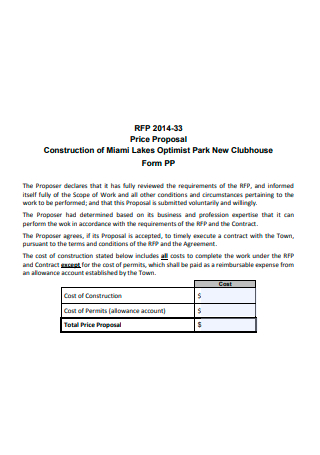
Construction Price Proposal Template
download now -

Construction Price Proposal Form
download now -
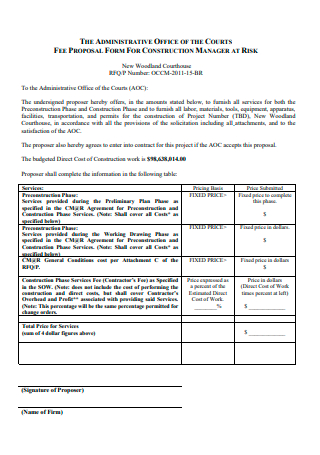
Construction Manager At-Risk Price Fee Proposal
download now -
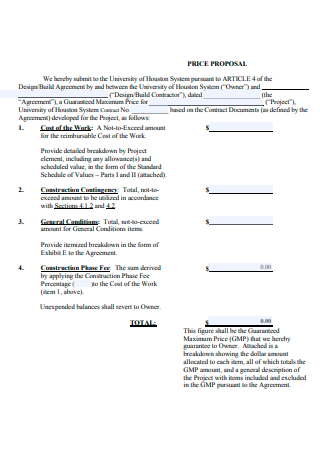
Construction Price Proposal Example
download now -
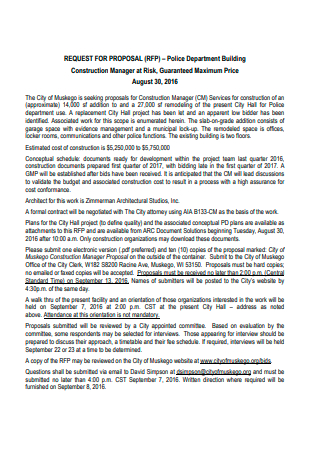
Construction Maximum Price Proposal
download now -

Construction Project Price Proposal
download now -
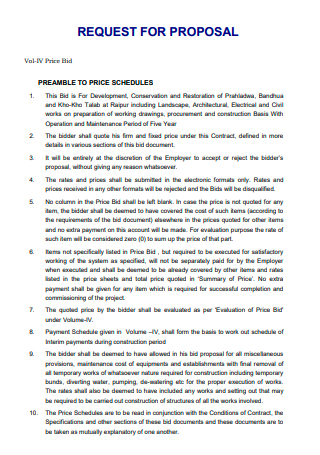
Construction Price Bid Proposal
download now
FREE Construction Price Proposal s to Download
6+ Sample Construction Price Proposal
What Is a Construction Price Proposal?
Benefits of Planning Early in Construction Projects
Tips to Draft a Construction Pricing
How to Write a Construction Price Proposal
FAQs
How do you put together a price proposal?
What percentage of a building project’s cost should be spent on labor?
What is the definition of a project schedule?
What Is a Construction Price Proposal?
A construction price proposal is a contractor’s initial estimate of the cost of a project for a potential customer. It is a document that establishes a settled price that the contractor will charge after estimating the prospective costs of completing the customer’s project. A cost proposal for construction can serve as your company’s showcase, protection, legal contract, and excellent marketing and sales tool. Without a construction cost proposal letter, you may encounter difficulties in finalizing the price of the project. Be sure to view a quotation sample to be guided as well as a contractor bid format for the reference.
Benefits of Planning Early in Construction Projects
The planning stage of any big project is the process of outlining the owner’s program and assessing its feasibility in terms of land usage, existing structures, and constraints. In favor of springing into the design and the preparation of blueprints and construction documentation, the planning phase is frequently performed hurriedly and perfunctorily without adequate consideration. Proper planning will decide how the owner’s vision can be realized. Industry studies have demonstrated a constant link between excellent planning and project success, proving that decisions made during the early stages of project definition provide the strategic structure for the project.
Tips to Draft a Construction Pricing
Since constructed facilities are so different, it’s almost necessary to have distinct pricing for each one. The elements that influence the pricing of a facility will differ depending on the type of institution and its location. All pricing arrangements, however, have some similar aspects in the form of legal papers binding the facility’s owner and suppliers. The most common types of documents with salary and wages can be described generically to show the fundamental concepts without addressing specific difficulties in different industries.
How to Write a Construction Price Proposal
If you listened to the advice mentioned above, then you have an idea of what the quotation format looks like, additionally, if you made use of the template then you already have a structure on how your construction price proposal will look like. But if you are not the type to use ready-made documents, then this guide will help you out just the same. It is important after all to cater to the specific needs of your client or building owner. Don’t shy away from referencing the construction proposal letter sample provided in this article because it will save you time.
Step 1: Owner and Construction Firm Information
Starting your construction price proposal would include all parties involved, most especially your client’s details; it must be spelled correctly with no errors, and it must include the complete address or company association and their most up-to-date contact information. Since the construction price proposal also outlines their responsibilities and duties, as well as any information or resources they must supply, it is important to clarify the identity of your client, otherwise, your effort could go to waste nor would they want an absentee construction company. The construction price proposal is, once again, security for you and your clients.
Step 2: Detailed Scope of Work
It is suggested that you make this part as detailed as possible, and list the services and duties you offer. You don’t want to be stuck doing something you didn’t agree to because your scope of work was insufficiently clear. If there is a specific task your construction team is not experienced at, then there is no reason to lie to the client. Instead, be upfront about it to save you and the client time and effort. No client wants to spend money on a task they needed to be insufficiently fulfilled. The work you will conduct should be detailed in your construction proposal.
Step 3: Setting the Project Schedule
It’s also important to include the proposed project’s start and conclusion dates because the prices you calculate are frequently predicated on the task starting and finishing on a specific day. If the dates vary, the cost of supplies and labor will likely fluctuate as well. You should also indicate the date on which all contractors were given the notice to proceed with the project. You should also state when milestones need to be met and who is responsible for delays, depending on the cause of the delay as this will provide you and your clients with even more protection.
Step 4: Cost Estimate
As the focused subject or intended data of this document, then the price of the construction project should be nothing less than missing specifications. In addition, your cost estimate should be extremely detailed, leaving no stone unturned. It must contain all direct expenditures, such as labor even including the subcontractors, equipment, and the quantity takeoff, which counts all materials required to finish the project, as well as an allowance amount. You must also account for all of your indirect costs, such as office rent and operating expenses. This is why specifying the work you do and schedule are important so that it can be resonated within this section.
Step 5: Payment Schedule
This part is critical to the cash flow of your business. It specifies the payment terms and conditions. Some of the requirements may be dictated by local construction industry laws and regulations, however, this section can protect you against clients who refuse to pay because they are in a dispute. You can specify whether the client pays their due when you meet milestones or on specific dates in this section. You can also mention when payments for extras or unanticipated issues are due.
FAQs
How do you put together a price proposal?
Since not everyone has the luxury to go over documents and paperwork, your price proposal should be easy to understand, brief, and accessible. It should include both direct and indirect costs of serving the potential customer, as well as proof that you deliver outstanding value for any money invested. Investigate the firm of a possible customer. It is highly recommended that you make use of a table or template to ensure no relevant information is left uncatered. You should also look into the sample quotation for a construction project to see how projects are priced.
What percentage of a building project’s cost should be spent on labor?
The cost of materials, the scale of the job, and other factors may all influence how much you charge for labor. However, according to The Construction Labor Market Analyzer, your construction labor expenditures should account for between 20% and 40% of total costs. Labor is often targeted first if and when budget savings are needed since labor costs are more variable than materials costs. The type and grade of materials utilized in the project, as well as overhead and margin, can all affect material costs. Be sure to consider this when doing a construction project estimate.
What is the definition of a project schedule?
The cost will very probably be influenced by the construction timetable. When a project has an excessively ambitious time, the price usually rises, especially if there is a hefty liquidated damages clause for failure to accomplish within a certain deadline. In contrast, if the award notice is extended beyond a reasonable time and the notice to proceed is indefinite, the contractor may be concerned about material cost inflation and may have other projects that take precedence. Any period longer than 60 days may result in higher bids.
Coming up with a construction price proposal won’t be easy nor will you be able to complete it right away. Since you will need to do some research on the cost of labor, materials, equipment, and other factors, you need to take your time in writing this document. But since not everyone has that luxury, then you should utilize the available cost estimate proposal template provided in this article.
